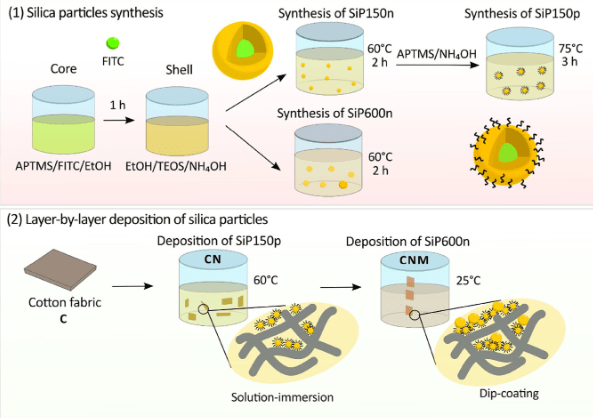Use of Silica Nanoparticles as Water and Dirt Repellent in Clothing
The integration of Silica nanoparticles also known as Silicon nanoparticles into textile manufacturing marks a significant advancement in fabric technology. This innovation has led to the development of clothing that is not only lightweight and comfortable but also possesses remarkable water and dirt repellent properties.
Utilizing the unique characteristics of Silica nanoparticles, manufacturers can now produce fabrics that offer enhanced protection against moisture and stains without compromising on breathability or texture. This technology has vast applications, ranging from outdoor and sportswear to medical uniforms, providing a new level of functionality and convenience in various clothing categories. The following sections delve into the specifics of how Silica nanoparticles achieve these properties and their implications in the textile industry. If you are exploring or planning to investigate their effects of textile production technology, examine Nanografi's high-quality nanomaterials.
Understanding Silica Nanoparticles
Silica nanoparticles are ultra-small particles made of Silicon Dioxide. They're used in various applications. These particles are incredibly tiny, typically 1-100 nanometers in diameter. Their applications are diverse, including uses in coatings for water and dirt repellency, catalysis, drug delivery, cosmetics, biosensors, material reinforcement, and lubrication. When handled correctly, Silica nanoparticles are generally safe, although inhalation exposure may have health risks. Additionally, they can replace harmful materials in some applications, offering environmental benefits. Overall, Silica nanoparticles offer unique properties and versatility in multiple industries.
How Silica Repels Water and Dirt?
The mechanism by which Silica nanoparticles repel water and dirt on surfaces, such as clothing, involves both the physical and chemical properties of these nanoparticles. Here's a brief explanation of the mechanism:
1. Hydrophobic Surface Modification: Silica nanoparticles are typically chemically modified to have a hydrophobic (water-repellent) surface. This modification involves attaching hydrophobic molecules or coatings to the nanoparticle surface. Common modifiers include silanes and fluoroalkylsilanes. This hydrophobic surface prevents water from wetting the surface and promotes water droplet formation.
2. Low Surface Energy: Hydrophobic Silica nanoparticles have a low surface energy, meaning they interact weakly with water molecules. As a result, water droplets tend to bead up on the surface rather than spreading out. This beading effect minimizes contact between water and the surface, making it difficult for water to penetrate or wet the fabric.
3. Oleophobic Properties: In addition to repelling water, some Silica nanoparticle coatings are oleophobic, meaning they also repel oils and dirt. This is achieved through modifications that make the surface resistant to oil and other hydrophobic contaminants.
4. Self-Cleaning Effect: The combination of hydrophobic and oleophobic properties on the fabric's surface creates a self-cleaning effect. When water or dirt particles come into contact with the coated surface, they tend to roll off or be repelled due to the low surface energy and the beading effect. This minimizes the adherence of dirt and stains to the fabric.
Technologies developed by drawing inspiration from the natural self-cleaning properties of lotus leaves are gaining new dimensions with the use of materials such as Silica nanoparticles. To find out what the lotus effect is, read our blog.
5. Durability: Silica nanoparticles, when properly applied to the fabric, are durable and can withstand multiple wash cycles without losing their water and dirt-repellent properties.
In summary, the mechanism of Silica nanoparticles repelling water and dirt involves modifying their surface to be hydrophobic and, in some cases, oleophobic. This modification reduces the surface energy, making it difficult for water, oils, and dirt to adhere to the fabric. Instead, these substances bead up or are repelled, resulting in a self-cleaning effect and improved protection for clothing and other surfaces.

Figure 1. Demonstration of hydrophobic fabric treatment with Silica nanoparticles.
Benefits of Using Silica Nanoparticles in Clothing
The incorporation of Silica nanoparticles into clothing offers a multitude of advantages that significantly enhance the performance and durability of garments. One of the primary benefits is the remarkable water and dirt repellency that these nanoparticles provide. Silica nanoparticle coatings make clothing both water-repellent and oleophobic, effectively preventing the penetration of moisture and the adhesion of dirt or stains. This not only keeps the fabric clean and dry, even in adverse conditions, but also imparts a self-cleaning effect, where water and dirt tend to roll off the surface. Such functionality reduces the need for frequent washing, contributing to the longevity of the clothing.
In addition to its repellency properties, Silica nanoparticle-coated clothing remains highly breathable, ensuring comfort and preventing a clammy feeling even in physically demanding situations. The durability of these coatings is also noteworthy, as they can endure numerous wash cycles without losing their water and dirt-repellent characteristics. This feature further extends the lifespan of the clothing, making it a practical choice for various applications, from outdoor and sportswear to work uniforms and everyday attire. Silica nanoparticles can even provide UV protection in some cases, safeguarding wearers from the harmful effects of sun exposure. Furthermore, these coatings are often considered environmentally friendly, as they do not contain perfluorinated compounds (PFCs), which can have negative environmental implications. Overall, the use of Silica nanoparticles in clothing presents an innovative and versatile solution that continually evolves through ongoing research and development.
Application Process in the Textile Industry
The application process of Silica nanoparticles in the textile industry involves a series of steps to create water and dirt-repellent coatings on fabrics. Initially, the appropriate Silica nanoparticles are selected based on their specific characteristics and compatibility with the fabric in question. These nanoparticles undergo surface modification to make them hydrophobic and oleophobic, rendering them water and dirt-repellent. They are then dispersed in a solvent to create a coating solution. The fabric is prepared by cleaning and pre-treating to ensure it is free from contaminants. Application methods, such as spray-on, dip coating, or roll-to-roll, are employed to uniformly apply the coating. After application, the fabric is dried to remove the solvent and undergoes a curing process, typically involving heat or UV radiation. Quality control tests are conducted to ensure the desired repellent properties have been achieved. Additional post-treatments may be applied to enhance durability, and finally, the treated fabric is fashioned into textile products ready for distribution. This process enhances the functionality of textiles, offering water and dirt-repellent properties that keep wearers clean, dry, and comfortable in various conditions.

Figure 2. Synthesis of silica nanoparticles (1) and coating by dipping (2)
Comparing Silica Nanoparticles with Other Repellents
When comparing Silica nanoparticles with other repellents like fluoropolymers (commonly known as Teflon), wax-based coatings, and chemical treatments, several key distinctions become evident. Silica nanoparticles provide an effective balance of water and dirt repellency, forming a hydrophobic and oleophobic barrier that resists both water and oil-based stains. They are highly durable and can withstand multiple wash cycles, ensuring long-lasting performance. Importantly, these coatings are thin and breathable, allowing moisture to escape and maintaining wearer comfort. Moreover, they are considered more environmentally friendly than fluoropolymers, as they do not contain the environmentally concerning perfluorinated compounds (PFCs).
In contrast, fluoropolymers offer excellent water and oil resistance, but their breathability may be compromised. However, they contain PFCs, which pose environmental concerns. Wax-based coatings, while providing some water repellency, are less durable and require frequent reapplication. Chemical treatments vary in performance, durability, and environmental impact depending on the specific formulation. The choice between these repellent options should be based on the specific requirements of the application and the importance of factors like breathability and environmental considerations, with Silica nanoparticles offering a compelling option in many scenarios.
You can read our blog post on the use and future of nanotechnology in the textile industry.
Safety and Environmental Implications
The utilization of Silica nanoparticles in various applications, while offering substantial benefits, brings about important safety and environmental implications that warrant consideration. Safety concerns arise from the potential risks associated with inhalation, skin contact, and eye irritation when working with these nanoparticles. Occupational safety measures, including protective equipment and controlled environments, are necessary to safeguard workers.
In terms of environmental implications, the behavior and persistence of Silica nanoparticles in the environment depend on factors such as size and surface modifications. Their long-term effects on ecosystems are still being studied, highlighting the importance of understanding their environmental fate. Proper waste management and disposal are essential to prevent environmental contamination, and the development of eco-friendly alternatives is a promising avenue to address these concerns while preserving the valuable functionalities of Silica nanoparticles. Overall, responsible handling, compliance with regulations, and research into environmentally safer alternatives are key strategies to balance the advantages of Silica nanoparticles with safety and environmental considerations.
Future Prospects of Silica in Textile Innovations
The future prospects of Silica in textile innovations are highly promising, driven by ongoing research and development. Silica nanoparticles have the potential to revolutionize the textile industry in various ways. Advanced coatings will provide textiles with even greater water and stain resistance, making them ideal for a wide range of applications. Sustainability is a key focus, and Silica-based coatings are being explored as eco-friendly alternatives to conventional repellents, aligning with the industry's growing commitment to environmental responsibility.
Future textiles will likely become multifunctional, incorporating water and stain resistance with other properties such as UV protection and antimicrobial features. Silica nanoparticles will also play a pivotal role in smart textiles, protecting electronic components from environmental factors. In healthcare, medical textiles with Silica nanoparticles may offer protection against pathogens. As nanotechnology advances, more precise and controllable Silica nanoparticles will allow for tailored properties in textiles, such as improved breathability and comfort. The future will also see an increased focus on regulatory considerations to ensure the responsible use of these innovations. Overall, the future of Silica in textiles holds great promise, addressing consumer needs and aligning with sustainability and environmental concerns in the textile industry.
Conclusion
In conclusion, the integration of Silica nanoparticles into textile innovations offers a bright and multifaceted future for the industry. These nanoparticles hold the potential to enhance textiles in various ways, from improving water and stain resistance to making garments more sustainable and multifunctional. With ongoing research and development, we can anticipate textiles that are not only highly functional but also environmentally responsible. From smart textiles that protect electronic components to medical textiles with antimicrobial properties, Silica nanoparticles are poised to revolutionize the industry's capabilities. As technology advances and regulatory considerations come into play, the textile industry will continue to harness the potential of Silica, shaping a future where textiles are more adaptable, durable, and aligned with the demands of a rapidly changing world.
Nanografi offers high quality advanced materials and solutions for advanced research, projects and technologies.
References
Following the Natures Lead: Lotus Effect Self-Cleaning - Nanografi Nano Technology. (n.d.). Retrieved January 16, 2024, from https://nanografi.com/blog/following-the-natures-lead-lotus-effect-selfcleaning/
Maia, M. T., Noronha, V. T., Oliveira, N. C., Alves, A. C., Faria, A. F., Martinez, D. T. S., Ferreira, O. P., & Paula, A. J. (2022). Silica Nanoparticles and Surface Silanization for the Fabrication of Water-Repellent Cotton Fibers. ACS Applied Nano Materials, 5(4), 4634–4647. https://doi.org/10.1021/ACSANM.1C03346
Paramsothy, M. (2021). Nanotechnology in Clothing and Fabrics. Nanomaterials 2022, Vol. 12, Page 67, 12(1), 67. https://doi.org/10.3390/NANO12010067
Swift, T. (2023). Stabilisation of acrylic latexes containing silica nanoparticles for dirt repellent coating applications. Polymer, 271, 125830. https://doi.org/10.1016/J.POLYMER.2023.125830
The nanotechnology in your clothes | Nanotechnology | The Guardian. (n.d.). Retrieved January 16, 2024, from https://www.theguardian.com/science/small-world/2014/feb/14/nanotechnology-clothes-nanoparticles
Use of Nanotechnology in Textile Industry and Its future - Nanografi Nano Technology. (n.d.). Retrieved January 16, 2024, from https://nanografi.com/blog/use-of-nanotechnology-in-textile-industry-and-its-future/
Recent Posts
-
Advanced Materials for Unmanned Aerial Vehicle (UAV) Protection Against Laser
Consider a UAV on a critical mission, rendered inoperative by a sudden laser attack. With the increa …26th Jul 2024 -
Simulation and Modeling of Material Properties
Our world is composed of a dazzling array of materials, each with its own unique properties that dic …19th Jul 2024 -
Advanced Coatings for Superior Corrosion and Wear Resistance
Corrosion and wear pose significant challenges across various industries, leading to substantial eco …12th Jul 2024






